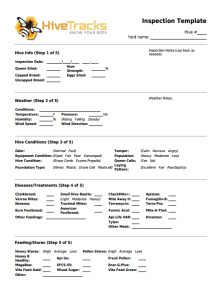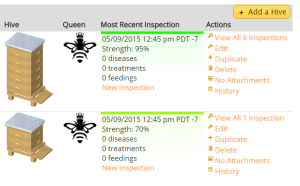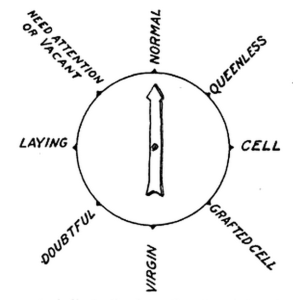Why? What? How?
 It is often recommended to new beekeepers that they should keep inspection records. Upon learning this, some would-be-beekeepers set a goal to keep meticulous notes and journal entries. But once they start working with the hive and juggling everything that goes on during an inspection, plus dealing with the thousands of bees and the euphoria or panic that can bring, record keeping is often forgotten. Or, many beekeepers just don’t know what kind of records to keep. How detailed do these notes have to be and how do they get it recorded with a busy schedule? After a few months of not keeping records at all, they may even fall into the mindset that it just isn’t needed.
It is often recommended to new beekeepers that they should keep inspection records. Upon learning this, some would-be-beekeepers set a goal to keep meticulous notes and journal entries. But once they start working with the hive and juggling everything that goes on during an inspection, plus dealing with the thousands of bees and the euphoria or panic that can bring, record keeping is often forgotten. Or, many beekeepers just don’t know what kind of records to keep. How detailed do these notes have to be and how do they get it recorded with a busy schedule? After a few months of not keeping records at all, they may even fall into the mindset that it just isn’t needed.
Let’s first tackle the why of record keeping.
When you have just one hive and you’re fairly new to beekeeping, it isn’t a very difficult task to remember everything that’s been going on with it. Unfortunately our memories can only recall that information for a finite period of time and then it is soon forgotten. Once you start accumulating more beehives, it becomes an even more difficult task to remember all the details. Or worse, you might get mixed up or confused about the various hives. Just ask my 3 children how good I am at keeping their names straight. So the reason we make notes is mainly to help us remember what we did and saw at each inspection.
These notes are important to helping us diagnose any problems we might see. They can be helpful when planning what to do next. Or when evaluating different methods or treatments, records become critical to understanding the effectiveness.
That brings us to wondering what we should be recording.
At the very minimum, the hive records should indicate the date of the inspection, the health and behavior of the bees, and any changes the beekeeper made to the hive. I recommend also going one step further and recording what needs to be done at the next inspection with a “to-do” date as necessary.
What kinds of “health and behavior” items should be recorded?
- Signs of disease? Symptoms or diagnosis?
- Brood health or laying pattern?
- Any queen cells?
- Eggs, larvae, capped brood?
- Temperament? Calm, nervous, angry? (Usually the bees, but maybe the beekeeper, if appropriate.)
Optional, but recommended data to record:
- Food stores – pollen/bee bread, nectar/honey
- The weather – temperature, pressure, etc (software can automate this)
- Hive equipment conditions
There are many actions a beekeeper would take during an inspection. Some of the most common would be:
- Adding/removing boxes
- Applying treatments or feedings
- Switching out boxes or combs
- Replacing the queen
- Splitting hives
- etc
But that’s a lot to record. How on earth do I do it?
This is really a personal preference and no one right way to do it. There are a few tools out there to help you, or you can create your own method. It can be as detailed or as simple as you want. Any effort is better than no effort. Here are some ideas.
Online tools or mobile apps
 These can simplify record keeping by prompting you with the things to record and organizing it in an easy to read way. It’s also nice to have the records available to you anywhere you are, whether at work or home. There are a couple popular tools.
These can simplify record keeping by prompting you with the things to record and organizing it in an easy to read way. It’s also nice to have the records available to you anywhere you are, whether at work or home. There are a couple popular tools.
Each of these have a simplified, limited free version, but otherwise require you to pay. This year PUB is getting a special offer to use the full version of Hive Tracks for a year for free as we help them test and improve the Groups feature of the software. If you would like to get a free year of Hive Tracks and help us test these new features, please email the PUB officers for details.
Notebook or Binder
If software is too complicated, or you don’t like the idea of getting propolis on your phone, you can just use a simple pen & paper. You can either create your own inspection check sheet or use one of the many that are available in books or online. This is even a good option with software if you can’t enter the inspection right away. (Hive Tracks inspection sheet)
Audio, Video, or Photos
Either a hand-held audio recorder or even a dictation app on your smartphone. Recording a quick sound-bite to send to someone else (a beekeeping partner perhaps) or to yourself for later recording is a great way to make some on-the-spot notes.
Taking photos or even video of the inspection can help in many ways. Digital photos would be time-stamped and can show things that are hard to put down on paper. Video can help us to see mistakes we might make as beekeepers and improve our technique.

Mark The Hive
Some people have even come up with clever codes or short-hand. You can attach cards or even dials on the hive for marking status. If you use a brick on the lid this can also be used to indicate the state the hive was in during the last inspection. The limitation of these methods is that they don’t indicate the date, but there are clever solutions to that. More importantly, it’s not a lasting record that can be referenced in the future. Part of beekeeping is learning year over year. Having records to review what happened the previous year (or years) can prepare us for the up-coming season. But this method can be good for quick notation or communication to other beekeepers who work the same apiary.
One very clever and simple hive marking technique used by Michael Palmer is using duct tape on the lid and writing on it, in his own short-hand, with a permanent marker.
Whatever method you use to keep track of your hives’ health and your interactions with them doesn’t really matter, as long as it works for you and is something you can keep up with. I recommend that beginners start with a check sheet of some kind. As you become familiar with filling it out, you’ll start getting into the habit of looking for the things on it. Once you become more comfortable with inspections and the check sheet, you can start scaling back and only record the things you find helpful and useful to get down on record. Eventually you’ll strike a balance that works well for you.
Other helpful tools:
Hive Tracks inspection sheet
“Honey Bee Calculator” Lifecycle Wheel
